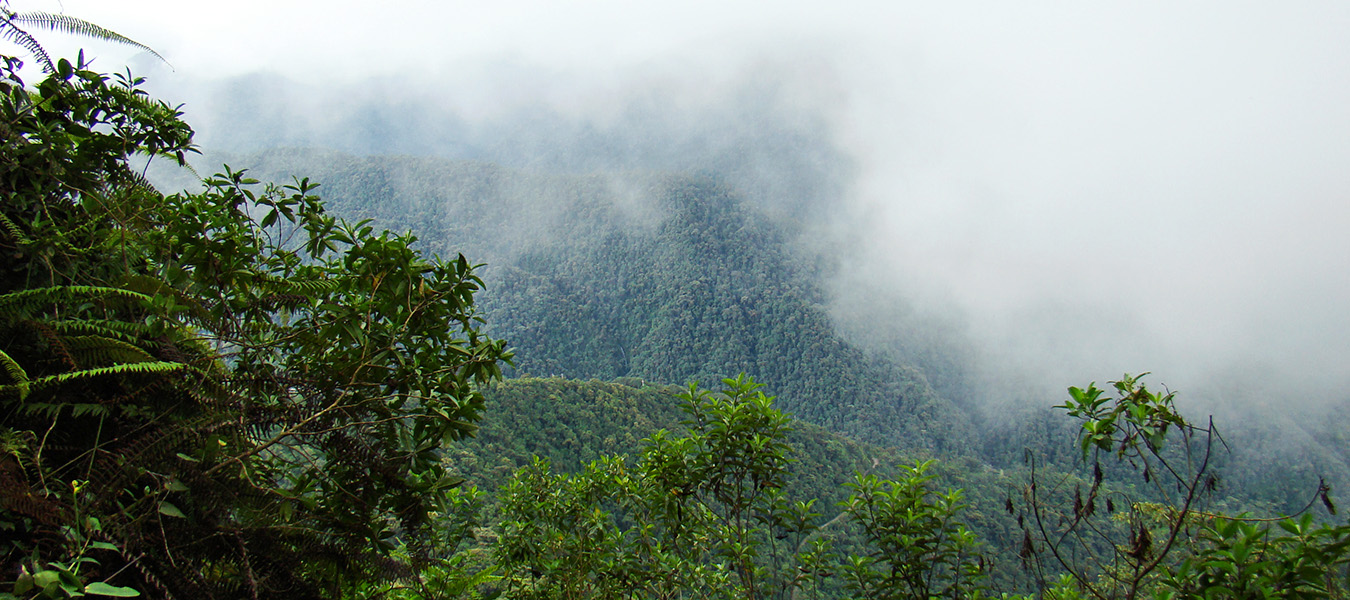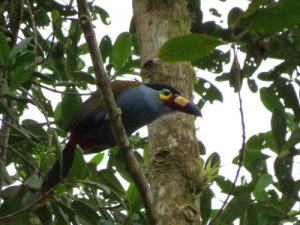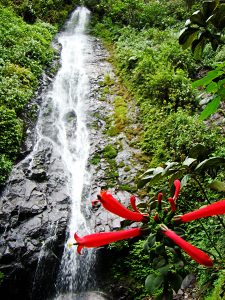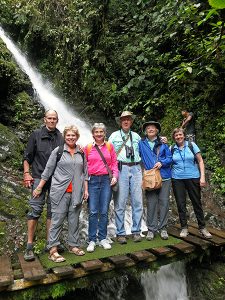
 Where tropical vegetation meets high mountains, there you find cloud forests. These ecosystems are characterized by dense forest clinging to steep slopes and bathed in nearly constant moisture provided by the clouds that form above and drift through the gnarled and moss-covered trees. The diffuse light, high humidity, abundance of gnarled tree trunks and twisting branches provide the perfect environment for growth of epiphytes: plants that spend their lives living on other plants rather than rooted in the ground. The most famous of these epiphtyes are orchids, which reach peak abundance and diversity in cloud forests, where they adorn the trees with flowers of ever color, size, and shape. Of course, there are some terrestrial species of orchids as well, but the epiphytic types display the greatest diversity, and include some of the world’s most famous orchids: Cattleya, Masdevallia, Dracula. Technically speaking, “cloud forests” are the uppermost component of what we call montane forests, those found between about 2500 and 12,000 feet of elevation (700 – 3500 m), but Ceiba largely works in true cloud forests above about 6500 ft (1900 m).
Where tropical vegetation meets high mountains, there you find cloud forests. These ecosystems are characterized by dense forest clinging to steep slopes and bathed in nearly constant moisture provided by the clouds that form above and drift through the gnarled and moss-covered trees. The diffuse light, high humidity, abundance of gnarled tree trunks and twisting branches provide the perfect environment for growth of epiphytes: plants that spend their lives living on other plants rather than rooted in the ground. The most famous of these epiphtyes are orchids, which reach peak abundance and diversity in cloud forests, where they adorn the trees with flowers of ever color, size, and shape. Of course, there are some terrestrial species of orchids as well, but the epiphytic types display the greatest diversity, and include some of the world’s most famous orchids: Cattleya, Masdevallia, Dracula. Technically speaking, “cloud forests” are the uppermost component of what we call montane forests, those found between about 2500 and 12,000 feet of elevation (700 – 3500 m), but Ceiba largely works in true cloud forests above about 6500 ft (1900 m).
 Cloud forest canopies provide a home to many other kinds of epiphytes, such as bromeliads (a family to which the well-known pineapple belongs), ferns, and aroids (for example, Philodendron). There are even epiphytic trees, that begin life as a seed deposited high in the canopy, where the grow to be a full-sized tree living on top of another tree! This profusion of flowering plants in the upper reaches of the cloud forest ecosystem provide a dense habitat rich with possibilities: a wide range of edible fruits, nesting sites for birds, water pockets in which to rear tadpoles, and hollow tree cavities where larger mammals breed and pass the daylight hours. Indeed, the tremendous abundance of fruits in the cloud forest explains the prevalence of some of this ecosystem’s most colorful residents, the large flocks of gaudily-decorated tanagers that flit rapidly across the slopes in search of trees laden with ripe fruits.
Cloud forest canopies provide a home to many other kinds of epiphytes, such as bromeliads (a family to which the well-known pineapple belongs), ferns, and aroids (for example, Philodendron). There are even epiphytic trees, that begin life as a seed deposited high in the canopy, where the grow to be a full-sized tree living on top of another tree! This profusion of flowering plants in the upper reaches of the cloud forest ecosystem provide a dense habitat rich with possibilities: a wide range of edible fruits, nesting sites for birds, water pockets in which to rear tadpoles, and hollow tree cavities where larger mammals breed and pass the daylight hours. Indeed, the tremendous abundance of fruits in the cloud forest explains the prevalence of some of this ecosystem’s most colorful residents, the large flocks of gaudily-decorated tanagers that flit rapidly across the slopes in search of trees laden with ripe fruits.
To the visitor, a cloud forest appears quite different than a typical lowland rainforest. The trees are notably shorter, due to slower growth rates and more frequent landslides and wind-throw events, and the understory is much more dense thanks to the increased penetration of sunlight through the lower and more ragged canopy. Moss and smaller epiphytes such as lichens and liverworts positively carpet every available surface: bark is practically impossible to find, as it is wholly enveloped by a living cloak of tiny plants. These little plants help the forest to retain water, which they extract from passing clouds much like a sponge set out on a humid day, and this stored water is one of the explanations for the cloud forest’s rich diversity of epiphytic growth.
 The rugged form of tropical mountains, especially in the Andes of South America, ensures that deep valleys are separated from one another by soaring ridges. This topographic complexity maintains a separation between groups of plants and animals, and much like Darwin’s finches diversified due to their isolation on disparate islands, the flora and fauna of the cloud forest have seen impressive rates of diversification. The result is an astonishingly high number of species packed into a relatively small area. For example, the Andes cloud forests harbor ten times as many unique mammal species as a similar area in the Amazon, and twice as many unique species of birds.
The rugged form of tropical mountains, especially in the Andes of South America, ensures that deep valleys are separated from one another by soaring ridges. This topographic complexity maintains a separation between groups of plants and animals, and much like Darwin’s finches diversified due to their isolation on disparate islands, the flora and fauna of the cloud forest have seen impressive rates of diversification. The result is an astonishingly high number of species packed into a relatively small area. For example, the Andes cloud forests harbor ten times as many unique mammal species as a similar area in the Amazon, and twice as many unique species of birds.
 Cloud forests provide a host of ecological services that benefit animals and humans alike. The provide refuge to plants and animals, since these forests are among the last to be converted to agriculture, owing to their steep and rocky slopes. Indeed, cloud forests often appear on satellite images as a network of mountaintop patches set among a sea of pastures and croplands. Despite this topographical advantage, tropical montane forests are highly threatened, and are being destroyed at a rate that exceeds that of Amazonian forests. They are subject to invasion for poaching, of timber for charcoal, of animals for meat or the pet trade, and of plants like orchids. Global climate change is also affecting cloud forest, drying them out and exposing them to greater levels of ultraviolet radiation; however, direct deforestation at the hands of humans remains their principal threat.
Cloud forests provide a host of ecological services that benefit animals and humans alike. The provide refuge to plants and animals, since these forests are among the last to be converted to agriculture, owing to their steep and rocky slopes. Indeed, cloud forests often appear on satellite images as a network of mountaintop patches set among a sea of pastures and croplands. Despite this topographical advantage, tropical montane forests are highly threatened, and are being destroyed at a rate that exceeds that of Amazonian forests. They are subject to invasion for poaching, of timber for charcoal, of animals for meat or the pet trade, and of plants like orchids. Global climate change is also affecting cloud forest, drying them out and exposing them to greater levels of ultraviolet radiation; however, direct deforestation at the hands of humans remains their principal threat.

This situation is most unfortunate, as intact montane forests are highly beneficial to human communities. The forests help to hold in place the mountainsides on which they grow, and rates of erosion and landslides are far higher in neighboring pastures than in intact cloud forest. They capture and hold immense levels of carbon, mitigating climate change. The presence of the shady, humid forest, and the moisture-capturing mosses, helps cloud forest to provide valuable water to regional rivers, water that is both steady in flow and high in quality. Indeed, around the world you will find national and regional conservation programs aimed at protecting mountainous forests that supply previous water to cities — such as Quito, Hong Kong, and Panama City — and to downstream agricultural areas that rely on a steady source of water.
Whether you are a bird in search of berries, an orchid seeking a pollinator, a city resident thirsty for a glass of water, or a tourist excited about hummingbirds and frogs and toucans, cloud forests have something incredible, and diverse, to offer. Visit the El Pahuma Orchid Reserve, and see for yourself!